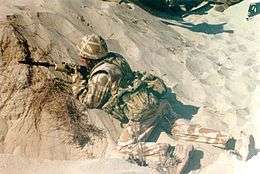Desert warfare
In desert warfare, the elements can sometimes be more dangerous than the actual enemy. The desert terrain is the second most inhospitable to troops following a cold environment. The low humidity, extremes of heat/cold, and lack of obstacles and wild-life allows the increased use of electronic devices and unmanned aircraft for surveillance and attacks.
| Part of a series on |
| War |
|---|
|
|
|
Related
|
Properties and tactics of desert warfare
The barrenness of the desert makes the capture of key cities essential to ensure the ability to maintain control over important resources (primarily clean water) and being able to keep a military well supplied. As such in conventional warfare this makes sieges a more frequent occurrence as the defender often prepares entrenched positions to protect the cities that they are supplied from.
Camouflage and cover

Many deserts have limited amounts of noticeable landmarks and as such maneuvering through a desert can turn into a logistical nightmare. Militaries often make use of cavalry to traverse the large expanses of a harsh desert without increasing the exertion of the soldiers who are already at a higher risk of dehydration because of the high temperatures during the day.
Mobility
Mobility is essential to a successful desert war. This explains the heavy use of armour in battles such as El Alamein in the Second World War. It has been noted that mobility is so important in desert warfare, that battles can sometimes begin to resemble naval engagements, where the actual possession of territory is less important than the positions of one's tanks (or ships).
There are many enemies to the desert fighter. These include aircraft, and tanks, which can be extremely menacing to desert guerrillas because there is little way to equal such force. Additionally, there are few places to hide from such weapons in the desert environment where there is little obstruction.
Another problem is the sand dunes, mobility is reduced by 60%. With no firm and stable ground footing it is easy to slide down or even get buried.
Water scarcity
Lack of water and extreme heat can also cause complications when engaging in desert warfare. Another lethal enemy is the landmine. Though not limited to desert use, it is a deadly device and underrated in its importance, as it is difficult to detect and can deny mobility. The scarcity of water may lead to change in bases, moving from one position to another looking for a water source.
Body temperature
In desert warfare an individual's body temperature can reach unusual highs causing fever-like weakness and dehydration.
Dehydration
An individual may have to face conditions of dehydration in desert warfare due to the lack of edible fluids and clean water.
Fatigue
Fatigue and bodily stress caused by the heat can cause very serious discomfort.
Sunlight can irritate eyesight.
See also
Important battles involving desert warfare

.svg.png)
_crowned.svg.png)

.svg.png)
_crowned.svg.png)

.svg.png)
_crowned.svg.png)




Important wars involving desert warfare





.svg.png)



.svg.png)

.svg.png)



.svg.png)

.svg.png)
.svg.png)

.svg.png)

.svg.png)
.svg.png)
_crowned.svg.png)









.svg.png)



%3B_Flag_of_Syria_(1963%E2%80%931972).svg.png)

%3B_Flag_of_Syria_(1963%E2%80%931972).svg.png)


.svg.png)



Ongoing desert warfare conflicts






